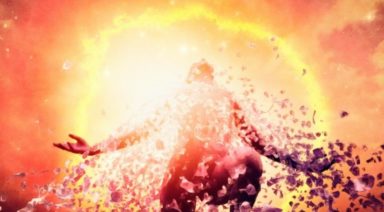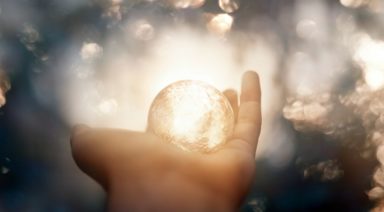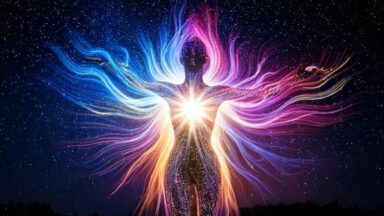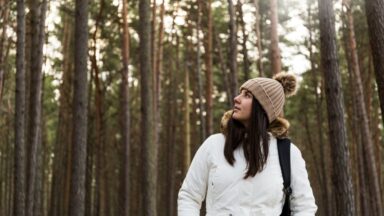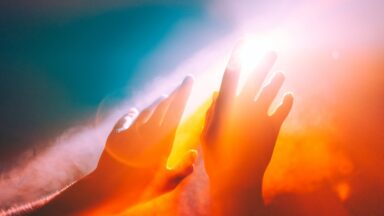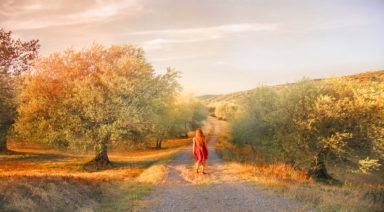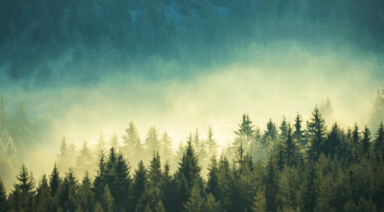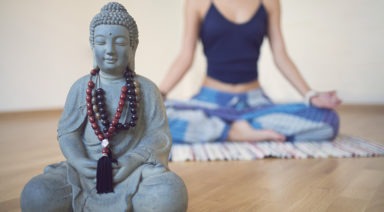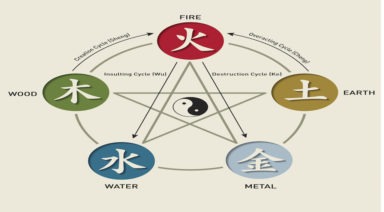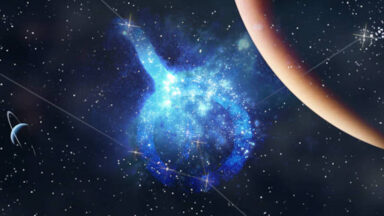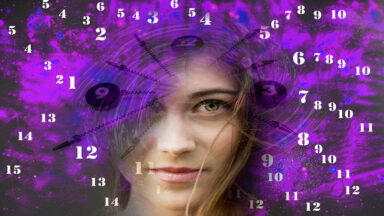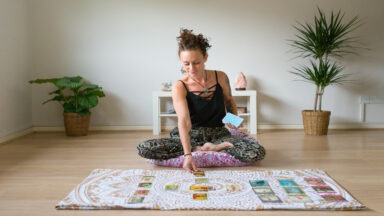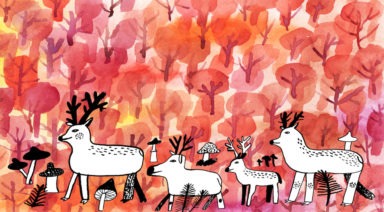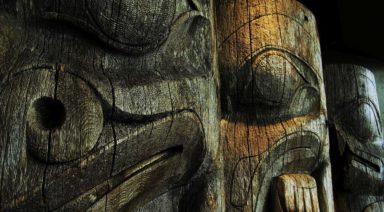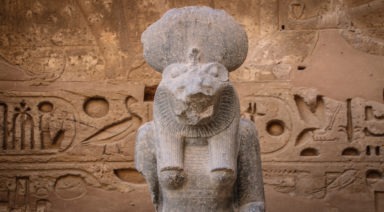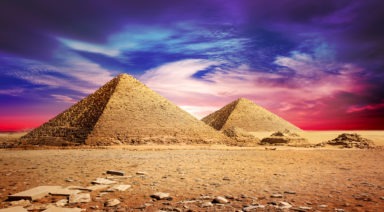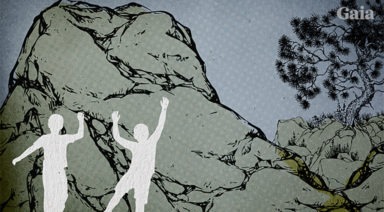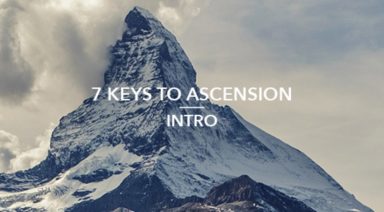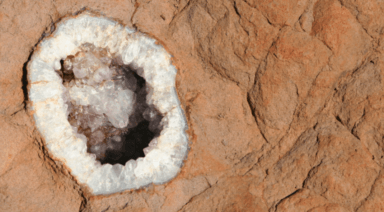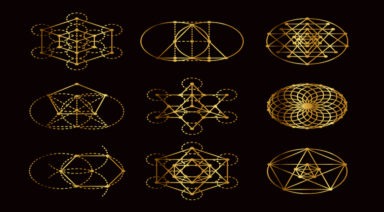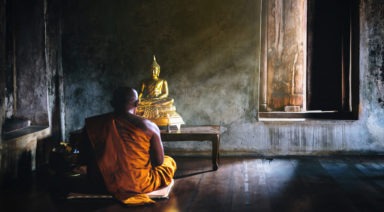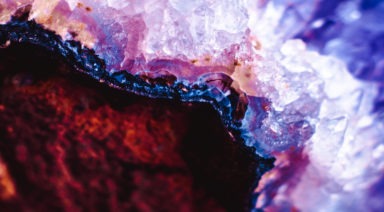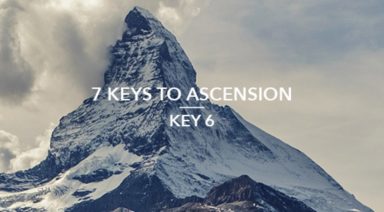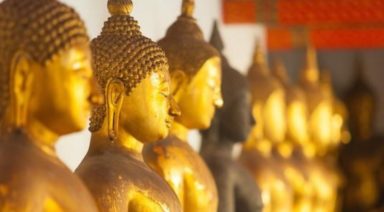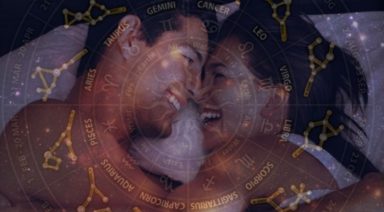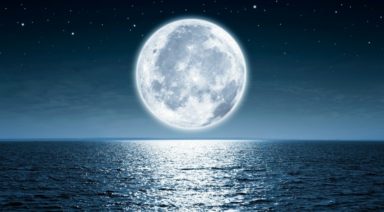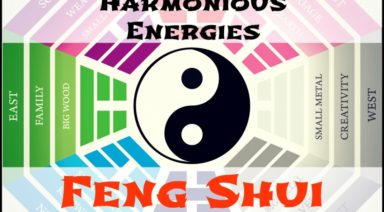The Rainbow Body Phenomenon in Tibetan Buddhism

The Old and New Testaments of the Bible, as well as ancient Greek and Egyptian texts, include stories of those who defied death through forms of ascension, from Jesus Christ’s resurrection to Heracles’s ascent to Mount Olympus to the god of the afterlife, Osiris. However, the most compelling tales of transcendence are found in the accounts of the Tibetan Buddhist rainbow body tradition.
While ascension stories are from the distant past, i.e., Enoch and Lazarus (Old Testament), it is debated whether they are fact or myth; examples of rainbow body events from this century are documented and available. Some believe that ascension and attainment of the rainbow body are the same thing. Still, arguably, there are differences—the Tibetan Buddhist rainbow body is the result of years of specific, disciplined practice with a motive of profound compassion for all beings.
In Tibet and Central Asia, the Buddhist rainbow body tradition goes back to the 8th century, beginning with the great master Padmasambhava, but 20th and 21st-century documentation shows that this is no myth or legend—practitioners, from the highest lamas to the most humble laypeople, have attained rainbow body.
What Is the Rainbow Body?
The rainbow body, or great transference, is a profound state of realization in Tibetan Buddhism, where, through advanced Dzogchen practices like Trekchö and Tögal, a practitioner’s body dissolves into light after death, often leaving behind only hair and nails. These methods cultivate the recognition of Rigpa—the true nature of mind—through three wisdoms: kadag (primordial purity), lhun grub (spontaneous presence), and thugs rje (compassionate energy). Physically, this transformation is marked by the body shrinking, emitting light, and sometimes even vanishing completely. Achieving this state represents mastery over mind and matter and the realization of pure light and energy.
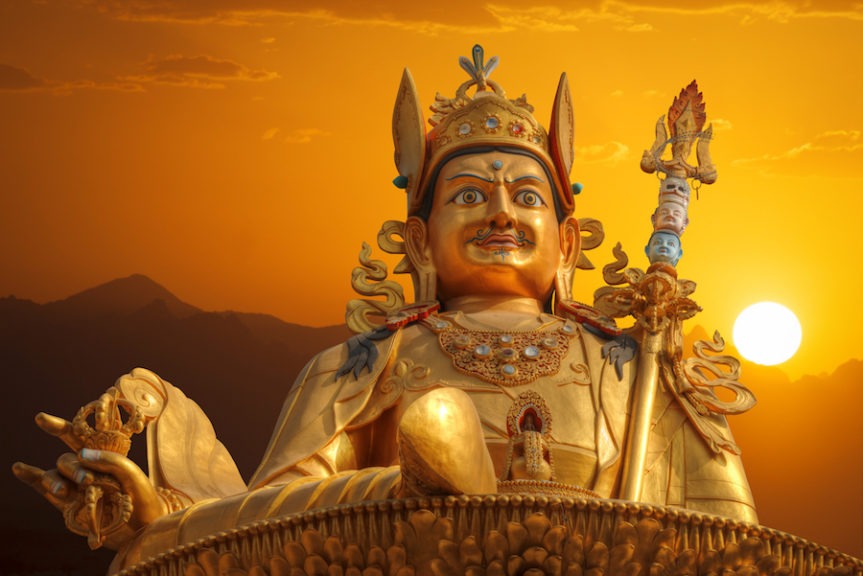
Gold Padmasambhava statue stands in Kathmandu, Nepal
Origins of Padmasambhava & the Rainbow Body
Let’s explore the legendary Padmasambhava, the “second Buddha,” whose teachings brought profound change to Tibetan Buddhism. His mastery of Dzogchen and miraculous acts led his disciples to attain the rainbow body, reshaping spiritual practices and the path to realizing one’s true nature.
The Prophecy of Padmasambhava
Before his death, the Buddha Shakyamuni prophesied that he would return as “one even greater than myself.” In the 8th century, Padmasambhava, later known as the “second Buddha,” appeared in Central Asia. According to legend, an eight-year-old child miraculously emerged from a lotus in Lake Dhanakosa in Oddiyana (modern-day Swat Valley, Pakistan), displaying the major and minor marks of a Buddha. King Indrabodhi, childless, adopted the boy, naming him Padmasambhava, or “Lotus Born.” Though he ruled as a prince, Padmasambhava soon recognized that political life and spiritual cultivation were incompatible. His purpose was to free sentient beings from suffering.
Banishment and Spiritual Transformation
After unintentionally causing the death of a minister’s son (whom he spiritually liberated), Padmasambhava was banished from Oddiyana. He embraced this as a chance to meditate in cemeteries, contemplating the transient nature of existence. Through this, he gained miraculous powers. Padmasambhava traveled through India, learning from masters and deepening his understanding of all things, from grains of sand to the universe.
The Miracle of Mandarava
In Zahor (Eastern India), Princess Mandarava renounced her royal life to practice meditation. She joined Padmasambhava, and together they achieved realization in the Maratika Caves. Her father, the king, sentenced them to death by fire, but instead of burning, the flames turned into a lake, and the two emerged unharmed, seated on a lotus. Stunned by the miracle, the king blessed them.
Padmasambhava’s Miracles and Teachings in Tibet
Padmasambhava performed countless miracles, transforming demons into protectors of the dharma. He brought Buddha’s teachings to Tibet, banishing its sacrificial religious practices, and spent 50 years teaching his 25 disciples. Eventually, he announced his departure to tame rakshasas, cannibalistic demons threatening India. Multiple witnesses reported seeing him ascend on a beam of sunlight, ride a lion into the sky, and disappear. He didn’t die—he simply left. Of all his teachings, Dzogchen is considered the most profound. His 25 disciples, along with many of their students, achieved the rainbow body according to his biography.
Origins and Cosmology of Dzogchen
Dzogchen, from the Tibetan “Dzogpachenpo,” meaning “great completion,” is a highly nuanced teaching. After receiving instructions from a qualified teacher, practitioners meditate to realize the “self-perfected state of our primordial nature.” The first stage, Trekcho, involves cutting through karmic and psychic debris, while the second stage, Togal, brings direct realization and dissolution of karma. According to Sogyal Rinpoche, Dzogchen requires enormous discipline and is best practiced under the guidance of a master.
The origins of Dzogchen are debated. Some say it originated from the Bon tradition, predating Buddhism in Tibet by 18,000 years, while others believe it was received from off-world beings. What is clear is that Dzogchen came to Tibet through Padmasambhava and has since been passed down in an unbroken lineage.
Michael Sheehy, in his review of Rainbow Body and Resurrection, describes Dzogchen’s cosmology: the cosmos begins as open and translucent, with the elements—air, fire, water, earth—forming all matter. Those who realize Dzogchen see themselves and everything as pure light in constant motion. The “rainbow body” refers to the elemental lights—white (space), red (fire), blue (water), green (air), and yellow (earth). Successful Dzogchen practitioners can reverse the densification process of matter into light, a concept that echoes in tantric, esoteric, and shamanic traditions worldwide.
Dzogchen Mastery of the Rainbow Body
Beyond Padmasambhava, several other esteemed masters are traditionally believed to have attained the rainbow body, underscoring the enduring depth and continuity of Dzogchen practice.
One such figure is Tapihritsa, a 7th-century master from the Bön tradition in the ancient kingdom of Zhang Zhung. After nine years of solitary practice in a cave near Mount Kailash, he is believed to have achieved the rainbow body. Tapihritsa is also known for appearing in visionary form to advanced practitioners, offering guidance and inspiration.
Another revered master is Vimalamitra, an 8th-century Indian scholar who played a pivotal role in establishing the Nyingma tradition in Tibet. Renowned for transmitting key Dzogchen teachings, he is said to have attained the rainbow body after extensive periods of deep retreat. According to tradition, Vimalamitra vowed to return to Tibet every century to continue guiding practitioners on the path of realization.
In cases like Tapihritsa’s, the most advanced level of realization is known as the Rainbow Body of Great Transference, in which the practitioner’s body dissolves completely into light, and their presence remains active in a subtle form to benefit others.
The origins of Dzogchen are debated. Some say it originated from the Bon tradition, predating Buddhism in Tibet by 18,000 years, while others believe it was received from off-world beings. What is clear is that Dzogchen came to Tibet through Padmasambhava and has since been passed down in an unbroken lineage.
Michael Sheehy, in his review of Rainbow Body and Resurrection, describes Dzogchen’s cosmology: the cosmos begins as open and translucent, with the elements—air, fire, water, earth—forming all matter. Those who realize Dzogchen see themselves and everything as pure light in constant motion. The “rainbow body” refers to the elemental lights—white (space), red (fire), blue (water), green (air), and yellow (earth). Successful Dzogchen practitioners can reverse the densification process of matter into light, a concept that echoes in tantric, esoteric, and shamanic traditions worldwide.
Types of Rainbow Body
In 2013, Dzogchen Khenpo Choga Rinpoche shared extraordinary news about his teacher, Lama Karma Rinpoche. After his passing, Lama Karma’s body, originally 5’9”, shrank to just 8 inches. This phenomenon, known as the “small rainbow body,” reflects the supreme accomplishment of attaining the state of a Buddha in one’s lifetime. Rinpoche clarified that “small” does not mean “lesser,” as all forms of rainbow body are signs of enlightenment.
Light Body and Medium Rainbow Body
Choga Rinpoche explained that if Lama Karma’s body continued to shrink and completely disappeared, it would be classified as the “light body” or “atomless body,” which can happen gradually or instantly, with or without witnesses.
He also described the “medium rainbow body,” where the body dissolves into rainbow light—rays, ribbons, and spheres—until only hair and nails remain. Historical examples include Master Nyaklha Rangrik Dorje, whose body now measures the size of a hand, and Tasha Lamo, a practitioner whose body shrank to about four inches in 1982.
The True Purpose of Spiritual Attainment
Despite the miraculous nature of these phenomena, Rinpoche emphasized that all such accomplishments are equal in their supreme attainment of Buddhahood. Practitioners do not seek these manifestations for spectacle or self-glory but as part of a deep commitment to the liberation of all beings. Any merit gained from their practice is dedicated to others, not the self.
In Buddhism, miraculous powers like passing through walls, leaving handprints in stone, or reviving the dead are mere by-products of accomplishment—not the goal. True Dzogchen practitioners avoid pride and hide their achievements to stay focused on their ultimate purpose: compassion and dedication to the freedom of all beings. Chasing such abilities for selfish gain risks falling into the realm of sorcery, where supernatural powers serve the self rather than others.
Proof of Rainbow Body
Explore accounts of individuals who experienced rainbow body, further demonstrating that this attainment is not limited to ancient times but continues to occur in modern history.
Rangjung Dorje
Tibetan Tantric Buddhism, influenced by the shamanic Bon tradition, resists simple definitions. Each instance of a great master’s death, especially when signs of rainbow body attainment are present, is unique and unpredictable. After a master’s breath and heartbeat stop, the body often remains upright in a meditation posture, without signs of rigor mortis. The area around the heart stays warm, as seen in the Sixteenth Karmapa, Rangjung Dorje, who passed away in a Chicago hospital in 1981.
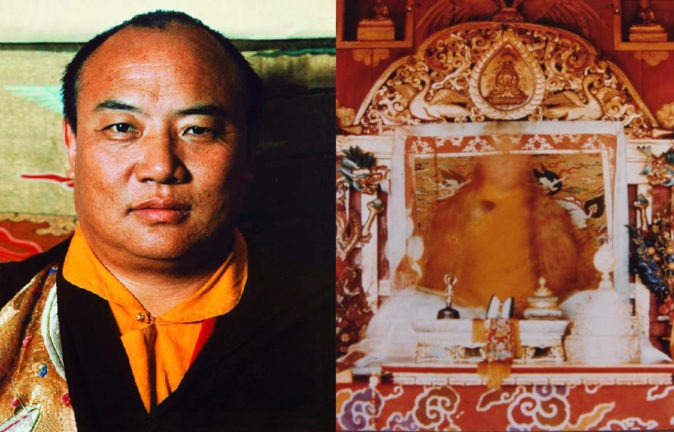
The 16th Karma Rangjung Rigpe Dorje. R. Photo of Karmapa during the Black Crown Ceremony
Karmapa, head of the Kagyu Lineage of Tibetan Buddhism, held the same stature as the Dalai Lama. He traveled to the West in 1974, foreseeing that Tibet would not gain independence from China. His attending physician, Dr. Mitchell Levy, shared a remarkable account of Karmapa’s death. After 45 minutes of failed resuscitation, Karmapa’s pulse and blood pressure unexpectedly returned, baffling the medical team. His chest remained warm for 48 hours, and there was no odor or decay. After three days, Karmapa’s body cooled, and the signs of death set in, marking the end of his deep meditation.
These post-death occurrences are common among highly realized beings, which is why Tibetan Buddhists refrain from moving or touching a body for three days after death, especially with meditation masters.
Karmapa also displayed signs of rainbow body before his death. In the 1970s, during the Black Crown Ceremony, a photograph was taken where his body appeared transparent. This image, considered a demonstration of the rainbow body, has since been widely circulated.
Khenpo Acho Rinpoche
Born in 1918, Khenpo Acho was from Eastern Tibet. From 1956 onward, he entered retreat and remained there for most of his life. He was known throughout the region as a great yogi and meditation master, and his death was the subject of an article by the Institute of Noetic Sciences in 2002.
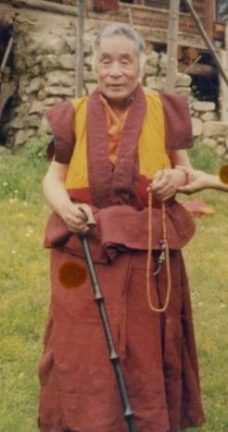
Khenpo Acho Rinpoche
“On August 29, 1998, Khenpo Achö, eighty years of age, attained physical dissolution. One day at noon, lying in bed without having suffered any recent illness, he attained Buddhahood, his heart of clear light reality perfected beyond the intellect. As his body dissolved into light, his wrinkles vanished, and he appeared like an eight-year-old child with a beautiful complexion.
“After a week had passed, when people learned of his death, they performed his death puja secretly [rainbow body practices are forbidden by the Communist Chinese] to deceive the authorities. At that time, rainbows appeared inside and outside, and a pleasant aroma filled the place. His body gradually diminished in size, and in the end, he attained Buddha; not even his nails and hair were left behind. It was just like a bird flying from a rock—people nearby had no idea where it might have gone,” said a witness.
Tasha Lamo
While little is said of female masters in the Tibetan Vajrayana tradition, women are certainly capable of achieving the realization that results in the rainbow body. Tasha Lamo was the mother of Lokgar Rinpoche of Nyingma Katok Monastery. She became a nun in her later years and was known as a great practitioner. After she died in India, her body shrank to about 12 inches.

Lama Achuk Rinpoche’s Rainbow Body Photo
Achuk Rinpoche was a revered meditation master—a “maha siddhi,” or one of great accomplishment. Born in 1918, he was noted for miraculous activities such as leaving hand and footprints in rock. When he died in 2011, his body shrank from 1.8 meters to one inch tall. Even years before his death, Rinpoche displayed signs of the rainbow body—the image of light appearing on a pink lotus was the result of a student’s simple photo of his master. None of the phenomena seen in the photo were apparent when it was taken.
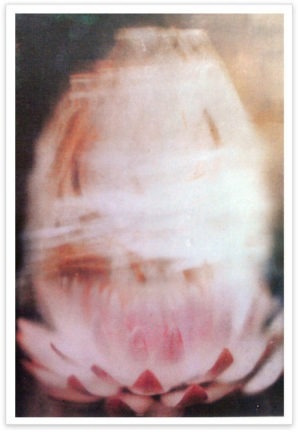
Photograph of Lama Achuk
Ogyen Tendzin
Namkhai Norbu Rinpoche, a meditation master from eastern Tibet, was among the first Tibetan lamas to openly teach Dzogchen in the West. He tells the story of his uncle, Ogyen Tendzin, who achieved the rainbow body at death.
As a child, Namkhai Norbu recalls trying to get his uncle to play with him during meditation. “I received my first Dzogchen teachings from my uncle when I was seven,” he said.
After the Cultural Revolution, Ogyen Tendzin lived alone, practicing Dzogchen. One day, a student and a Chinese official knocked on his door but found only his robe on the bed. Inside, they discovered a small body, realizing he had passed. Days later, when they returned, only hair and nails remained.
“The rainbow body still exists today —it’s not just from ancient times,” Rinpoche said.
The rainbow body phenomenon illustrates the remarkable spiritual tradition within Tibetan Buddhism, offering a glimpse into the profound depths of Dzogchen practice. These accounts of transformation, both ancient and modern, serve as powerful reminders of the boundless possibilities of human realization and the mastery of the material body.
What Is Light Body Activation and How to Activate Your Spirit Guide?
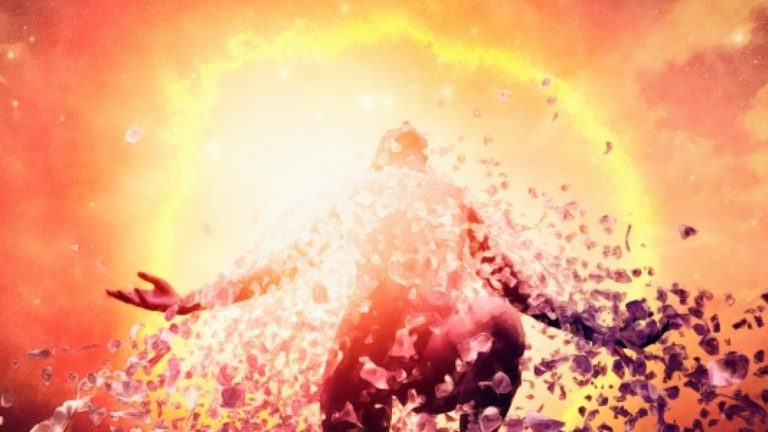
The evolution of mankind is progressing more rapidly than at any other time in recorded history. With growing unrest, we look not to the future but to the teachings of the past to bring greater meaning to our human existence. When we dive deeply, we find the forgotten knowledge of the Mystery Schools: legends of people levitating, yogis living hundreds of years, and even walking through walls. For each tradition, the teachings of the light body were those skills reserved for the highest initiates, forming the foundations of these god-like feats.
What Is the Light Body?
The light body is a metaphysical concept found in spiritual traditions across the world. It represents a higher, energy-based existence beyond the physical body, often described as a vehicle for spiritual awakening, ascension, and expanded consciousness. While invisible to the naked eye, the light body is thought to interpenetrate and surround the physical form, acting as a bridge between earthly and higher dimensions.
Ancient spiritual systems have described the light body in various forms. In Egyptian mysticism, it is linked to the Ka or energy double; in Hindu philosophy, it corresponds to the subtle body and chakra system; and in Tibetan Buddhism, it aligns with the rainbow body—a sign of spiritual mastery. Western esoteric traditions refer to it as the Merkaba or “chariot of light,” used to access higher planes of existence.
In all of these lineages, activating the light body is seen as an essential part of spiritual evolution. It symbolizes the soul’s journey toward merging with divine consciousness through practices that purify, elevate, and align the self with universal energy.
Elements of the Light Body
The human energy field is made up of several layers. The terms etheric body, mental body, astral body, and emotional body are all aspects of the light body. Beyond these densities are further ways to activate the higher functions of the light body.
In electrical impulses, energetic bodies beyond the physical can be detected. Aura photos, also known as Kirlian photography, can capture images of these bodies. Shamans and gifted healers regularly work within these fields.
MerKaBa
This is an Egyptian term translated as Mer (light) Ka (soul) Ba (body).
It’s known as the chariot of the soul and must be activated to achieve ascension.
Drunvalo Melchizedek has taught this knowledge extensively. Specific breathwork combined with visualization can activate the light body as sacred geometry around the physical body.
Rainbow Body
Once the light body is activated, more sincere practices in absolute love are necessary to elevate the light body to the rainbow body state.
The rainbow body is the result of maintaining a constant frequency of unconditional love.
Having healed every wound, purified every thought, and released every judgment, the rainbow body will ignite. It’s an absolute unwavering of this vibration that allows us to achieve ascension.
Both Jesus and Buddha ascended in this form. In their perfection of the human, they became “gods” and showed others the way to accomplish this frequency. The teachings of both masters are instructions illuminating the path for others to follow.
Experiencing the Light Body
“If you have good thoughts, they will shine out of your face like sunbeams, and you will always look lovely.” Roald Dahl
Have you ever been around someone who exudes sacredness? Amma, for example, comes to mind. As soon as you’re in their presence, you feel peaceful, inspired, and more fulfilled. Way beyond charisma, this is a direct experience of a highly activated light body.
Being near them is discernible in your own body. The magnitude of their field influences your vision, mind, and spirit.
In the presence of such beings, we’re being activated ourselves, brought into greater spiritual alignment and shown we are capable of such mastery too.
To activate a light body is not the work of gurus and masters. It’s a way of being intended for every living being who wishes to pursue it.


